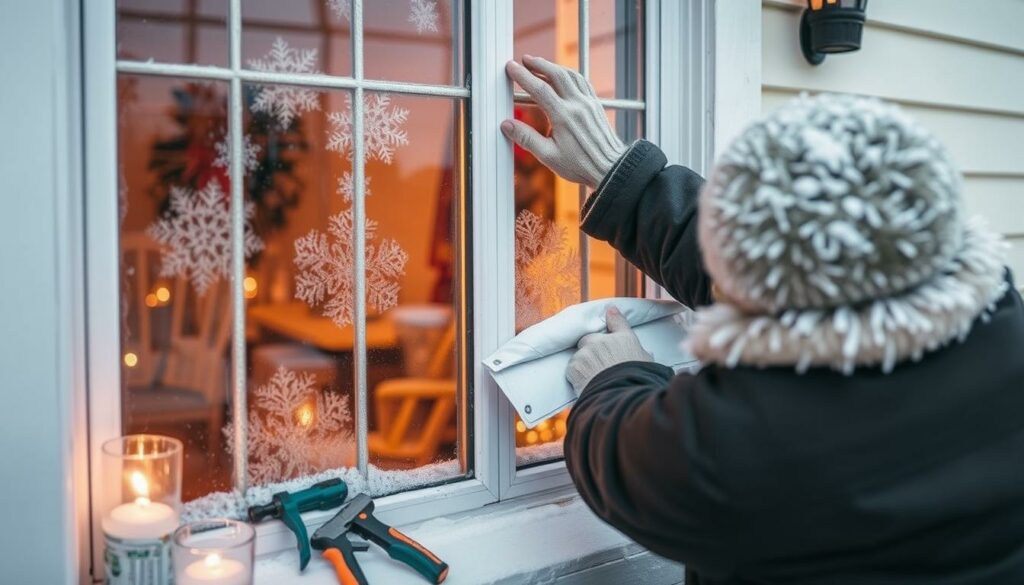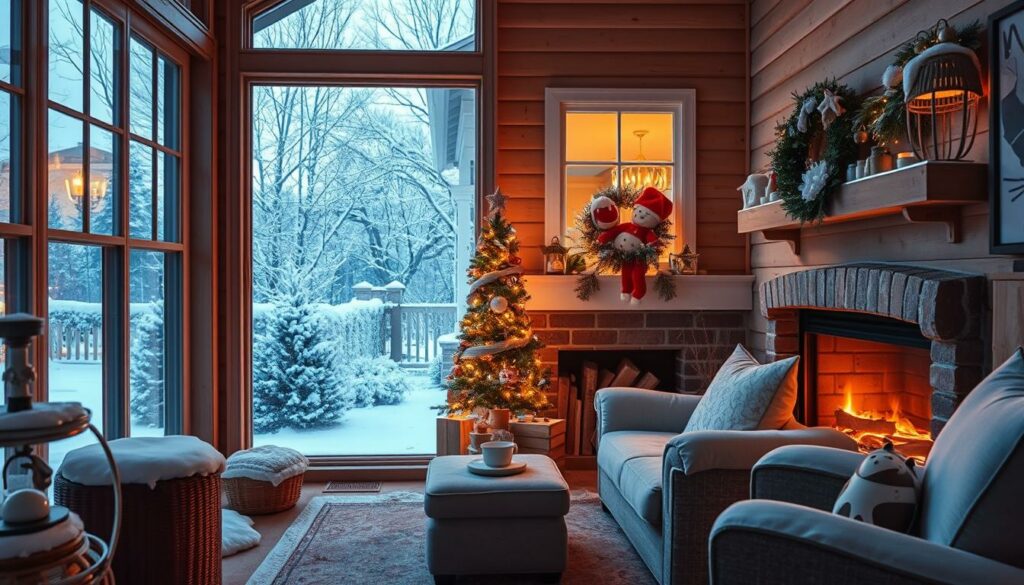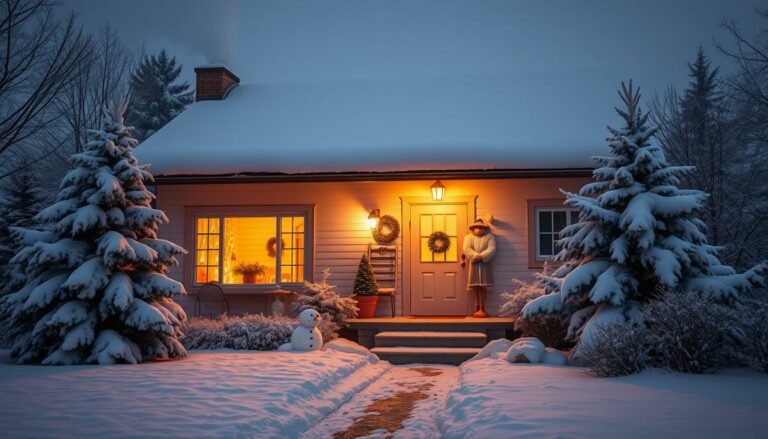As the temperature drops and the first snowflakes begin to fall, it’s crucial to ensure your home is ready to withstand the colder months ahead. In fact, residential fires are more common in winter, highlighting the need to take proactive steps to winterize your home and protect your property.
This comprehensive guide covers the essential tasks and tips you need to know to effectively winterize your home. This includes inspecting and cleaning gutters, servicing your heating system, and implementing energy-efficient measures. By following these steps, you can safeguard your home and minimize the risk of costly damage or disruption during the winter season.
Key Takeaways
- Winterizing your home is crucial to protect your property and prevent costly damage.
- The process involves a range of tasks, from inspecting and cleaning gutters to servicing the heating system.
- Implementing energy-efficient measures can help you save on utility bills and keep your home warm throughout the winter.
- Preparing for snow removal and roof maintenance are also important aspects of winterizing your home.
- Regular home maintenance and inspections can help you identify and address potential issues before they become larger problems.
Inspect and Clean the Gutters
Keeping your home’s gutter maintenance in check is key to protecting your roof and avoiding expensive water damage. Clogged gutters can cause ice dams, leading to roof care problems and water leaks inside your home. It’s vital to regularly inspect and clean your gutters to ensure they work right.
Gutter Cleaning Tips
Experts say you should clean your gutters at least twice a year, in spring and fall. If you have pine trees or other trees that shed leaves near your home, you might need to clean them more often, like every three months. Here are some tips for cleaning your gutters:
- Start at the downspout and work your way towards the closed end of the gutter.
- Use a telescoping gutter wand or hire a professional for a thorough clean.
- Avoid cleaning gutters right after rain, as the debris will be wet and harder to remove.
- Have two buckets ready – one for debris and one for flushing the gutters after cleaning.
- Check downspouts for any clogs or lodged debris after cleaning the gutters.
- Ensure proper gutter drainage and slope to prevent water from pooling.
- Seal any leaking seams and joints with gutter sealant.
- Consider installing gutter guards to reduce cleaning frequency.
By following these gutter maintenance tips, you can keep your gutters clear and working well. This protects your home from water damage and prevents ice dams.
Attic Insulation and Ventilation
Proper attic insulation and ventilation are key for your home’s energy efficiency in winter. The attic helps keep heat in and cold out. This saves energy and makes your home more comfortable.
Experts say your attic should have R-value insulation between R-38 to R-49. This means about 13 to 18 inches of insulation. It keeps your home warm and can also make your roof last longer by preventing heat damage.
Good attic ventilation is also vital. You need about 1 square foot of ventilation for every 150 square feet of attic space. This airflow helps control temperatures, prevents ice dams, and stops moisture buildup that can cause mold and mildew.
To get the best ventilation, you need a balanced system. Use roof vents near the roof peak and soffit vents at the eaves. This ensures air flows well.
It’s important to regularly check and maintain your attic insulation and ventilation. A professional, like RoofPRO, can give you advice and help your home get ready for winter.
| Insulation Type | R-Value | Recommended Depth |
|---|---|---|
| Fiberglass | R-3 to R-4 per inch | 13 to 18 inches |
| Cellulose | R-3.7 to R-3.8 per inch | 13 to 18 inches |
| Rigid Foam Board | R-5 to R-6.5 per inch | 3 to 6 inches |
| Spray Foam | R-6 to R-7 per inch | 3 to 6 inches |
Investing in good attic insulation and ventilation is key to winterizing your home. It makes your home more comfortable and can save you money on energy bills.
Protect Pipes from Freezing
As the temperature drops, protecting your home’s pipes from freezing becomes a top priority. Frozen and burst pipes can cause significant water damage, leading to costly repairs. To safeguard your plumbing, consider these pipe insulation methods:
Pipe Insulation Methods
First and foremost, insulate exposed pipes, especially in the attic, basement, and crawl spaces. Pipe wrap or other insulation materials can help retain heat and prevent freezing. Aim to keep the thermostat at a minimum of 68 degrees Fahrenheit to help maintain a consistent temperature around the pipes.
- Insulating pipes can reduce the likelihood of freezing and bursting during severe winter weather.
- Checking pipes for visible damage twice a year is recommended to prevent freezing.
- Running warm water on outer wall faucets at a slow drip can help prevent freezing.
- Covering outside faucets with outdoor faucet covers or freeze caps before winter can aid in preventing freezing.
In addition, know the location of your main water valve and learn how to shut it off in case of an emergency. This way, you can quickly stop the flow of water and minimize the damage if a pipe does burst.
By taking proactive steps to protect your frozen pipes and burst pipes, you can help ensure your home’s plumbing system remains in good working order throughout the winter months and reduce the need for costly plumbing maintenance.
“Burst pipes represent one of the most common causes of property damage in the wintertime, often leading to thousands of dollars in water damage.”
Winterize Windows and Doors
As winter gets closer, it’s key to make sure your home is ready. You need to stop air leaks and keep your home warm. Winterizing your windows and doors is a great way to do this.
First, check your windows and doors for any gaps. Use caulk and weather stripping to seal them. Adding thermal-lined curtains or window film can also help keep the heat in.
For your doors, use door sweeps to block cold air. Make sure the weatherstripping is in good shape. You can also use draft stoppers to seal any gaps.
If your windows are old or single-pane, think about getting new ones. Energy-efficient, double-pane windows can save between $100 and $500 in energy bills every year. They last about 15 years with the right care.
Don’t forget about your skylights. They can also let cold air in. Make sure they are sealed well to keep your home warm and energy-efficient.
By sealing your windows and doors, you can make your home more energy efficient. This will help reduce air leaks and make your home more comfortable all winter.

Service Heating System
As winter gets closer, it’s key to check your home’s heating system. Make sure it’s working well and safely. A pro can inspect and service your furnace or boiler before the cold hits. This can cut your energy bills, avoid sudden breakdowns, and keep your home cozy.
Getting your furnace checked by experts can make it last longer. Service Champions, a top HVAC company in Southern California, suggests yearly checks. Their team gets 150 hours of training yearly to ensure they can inspect and tune your system right.
Think about getting a smart thermostat too. It can adjust your home’s temperature for you, saving energy and keeping you comfy. Also, change your air filters often to boost your system’s efficiency and air quality.
| Service | Provider | Highlights |
|---|---|---|
| Heating System Installation, Repair, and Maintenance | Accurate Electric, Plumbing, Heating, and Air | – Experienced in central air furnaces, heat pumps, and steam/hot water systems – Offers natural gas and hydronic radiant heating options – Provides 24/7 emergency services – Serves the Glendora area |
| Heating System Replacement and Upgrades | Reliable Air Conditioning | – Carrier Factory Authorized Dealer – Offers high-efficiency heating products – Provides financing options for homeowners – Serves North Hollywood and surrounding areas |
Getting furnace maintenance and boiler service from pros is smart for winter. It keeps your HVAC efficiency up. This way, you can stay warm and cozy while maybe saving on energy costs.
“Routine maintenance by professional technicians ensures efficient running of heating systems and helps prevent costly repairs later on.”
Home Maintenance
Getting your home ready for winter is more than just checking big systems. Move outdoor furniture, grills, and tools inside to keep them safe. Make sure your snow blowers are ready and have all the snow removal gear you need. Inside, test your smoke and carbon monoxide detectors and tackle any other maintenance tasks to keep your home safe and cozy.
Keeping up with home maintenance all year is key. Check smoke and carbon monoxide detectors monthly and replace the batteries. Clean bathroom tiles and grout often to stop mold and mildew. Also, check your home’s big systems, like plumbing, regularly to catch problems early.
- Regularly clean slow-running drains to prevent major backups
- Check gutters for clogs or improper drainage to maintain proper water flow
- Restock cleaning supplies to ensure you’re prepared for home maintenance tasks
- Conduct a monthly walk-through of the entire property to identify developing issues
- Update your home inventory after significant investments in furnishings or appliances
Seasonal home maintenance is also vital. Cleaning your gutters in spring and fall is crucial. Also, deep-clean your home at least twice a year. Don’t forget to clean and check your HVAC system every six months, and change filters monthly.
Some tasks need a pro, like HVAC maintenance, plumbing cleaning, gutter cleaning, and roof inspections. By focusing on both seasonal home prep indoors and outdoors, you’ll make sure your home is ready for any weather. This will also protect your outdoor equipment and indoor tasks.

Prepare for Snow Removal
As winter gets closer, it’s key to get ready for snow and ice. Having the right tools for snow removal is crucial. From snow blowers to shovels, the right equipment helps keep your place safe and clear.
Snow Removal Equipment
A well-kept snow blower can change the game for snow removal. Make sure to service it before the first snow. Also, have shovels, ice melt, and sand or salt ready to clear your driveway, sidewalks, and steps.
A roof rake is also a must-have. It helps prevent ice dams on your roof, which can cause water damage. Regularly using a roof rake keeps your home safe from winter weather.
- Properly maintain and service your snow blower before the season begins
- Stock up on shovels, ice melt, and sand or salt for driveway and walkway clearing
- Consider investing in a roof rake to prevent ice dams and water damage
Being ready for snow removal is key. With the right tools, you can face winter weather confidently. This keeps your property safe and accessible all season.
| Item | Purpose | Estimated Cost |
|---|---|---|
| Snow Blower | Clearing driveways and sidewalks | $300 – $1,000 |
| Snow Shovel | Clearing small areas and steps | $10 – $50 |
| Ice Melt | Preventing and melting ice on surfaces | $10 – $50 per bag |
| Roof Rake | Removing snow buildup on roofs | $20 – $100 |
Getting the right snow preparedness equipment is vital. It ensures your property stays safe and accessible all winter. By preparing and stocking up on essential tools, you can handle driveway clearing and ice prevention with ease. This keeps your home and family safe during the cold months.
Roof Inspection and Repair
Your roof is key to your home, especially in winter. Regular roof maintenance helps avoid expensive fixes and keeps your roof lasting longer. Look for broken, curled, or missing shingles, clogged valleys, and bad flashing early on.
A pro roof check can find hidden damage and spot problems like ice dams and shingle damage. These can cause leaks and water harm if not fixed. Think about putting up snow guards or roof heat cables to stop ice dams from damaging your roof and gutters.
- Look for broken, curled, or missing shingles
- Check for clogged valleys and deteriorating flashing
- Clear any debris from the roof
- Install snow guards or roof heat cables to prevent ice dams
Fixing roof problems early can save you from expensive fixes later. Regular roof maintenance is a smart choice to protect your home and keep it in great shape.
| Roof Inspection Cost | Roof Repair Turnaround | Roof Inspections Performed |
|---|---|---|
| $100 or more | 1-2 business days | More than any other roofing company |
“Roof Reports issued by licensed roofing contractors detail current roof conditions, necessary corrective actions, and future problem prevention requirements.”
Energy Efficiency Measures
Upgrading your home for energy efficiency can cut down on utility bills and make your home warmer in winter. By focusing on energy savings, weatherization, and programmable thermostats, you can lower your home’s energy use. This makes your home more efficient overall.
Sealing air leaks in your home is a key step to better energy efficiency. This can save you 5% to 30% on energy each year. Also, switching to energy-efficient windows, like storm windows, can cut heat loss by 25% to 50%.
Getting a programmable or smart thermostat can also save you money. These devices can adjust the temperature automatically. This can save up to 10% on your heating and cooling costs each year.
Insulating your attic properly is also important. It can stop up to 60% of heated air from escaping. Upgrading your heating and cooling systems can also cut energy use by 20% to 50%.
By taking these steps, you can lower your utility bills and help the environment. Check with your local utility company for energy assessments or rebates on energy-saving home upgrades.
Conclusion
Properly winterizing your home is key to protect your property, cut down on energy costs, and keep your family cozy during the cold months. By following the steps in this guide, you can get your home ready for winter and dodge expensive repairs or damage. Start the home preparation early and fix any problems quickly to make sure your home can handle the seasonal readiness of winter weather.
From checking and cleaning gutters to fixing your heating system, each step in home maintenance is vital to keep your home safe, efficient, and warm all winter. By doing these important tasks, you’ll not only safeguard your investment but also have a more energy-smart and cozy living space.
Regular maintenance is the secret to a well-prepared home. By being proactive and fixing issues before they get worse, you can make sure your home is ready for winter’s challenges. So, take the right steps to winterize your home and feel confident in a well-kept property.
FAQ
Why is it important to winterize my home?
How do I clean and maintain my gutters for the winter?
What steps should I take to ensure proper attic insulation and ventilation?
How can I protect my pipes from freezing?
What can I do to winterize my windows and doors?
How do I prepare my heating system for the winter?
What other home maintenance tasks should I complete to prepare for winter?
What snow removal equipment and supplies should I have ready?
How should I inspect and maintain my roof for the winter?
What energy-efficient upgrades can I make to my home for the winter?
Source Links
- Growing Bonsai: Tips for Miniature Tree Enthusiasts
- Buying Bonsai: Tips for Selecting Your Perfect Tree
- Bonsai Potting: Essential Tips for Tree Care Success
- Bonsai Maintenance: Essential Care for Tiny Trees
- Mastering the Art of Shaping Bonsai: A Beginner’s Guide


